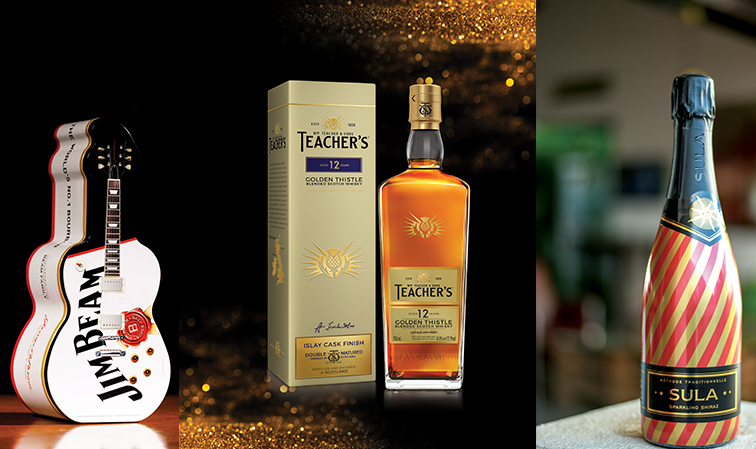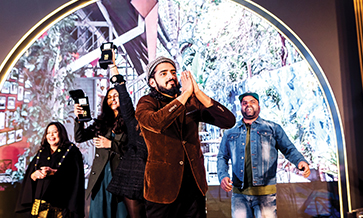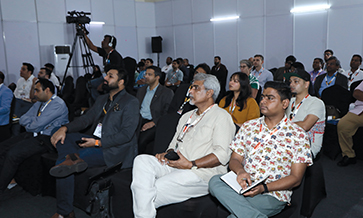The manufacture of alcoholic beverages in India – be it beer, wines or spirits – has seen rapid developments, with the trend being heavily biased towards craft drinks and unique experiences. Although the media has made familiar what small and mid-sized companies or start-ups are doing, Brews&Spirits takes a closer look at innovation by multi-nationals and large companies in the alcoholic beverages space in India.
The increasing tempo of innovations in the spirits and beer sectors in the country has witnessed local botanicals rise above the ordinary in craft gin, spiced rum, and single malts, all of which have also made rapid strides in the global markets.
There has been a sharp shift towards craft beer, led by brands like Geist, Gateway Brewing and White Rhino, of an explosion of microbreweries across metros, and the brew being packaged in different forms: on tap, in bottles, from kegs and cans.
There is also a revival of interest in native spirits derived from the likes of agave plant, mahua flower, toddy palm (coconut) sap and cashew pulp. There is growing awareness and liking for wines and ciders being made using not only locally grown grapes but also from Chikkoo (Sapota) and organically grown Kiwi.
The prospects for innovation appear ripe to us from a consumer sentiment – a new breed of well-travelled and well-heeled people are looking for new products and experiences. We talk of innovation in terms of new product development, their placement and branding, packaging and distribution.
Large companies, with a robust record of research and development, wealth of capital, marketing savvy, and distribution reach are best positioned to take advantage of the consumers’ thirst for novelty. So, what have they been up to lately?
Blending and packaging
According to Mr Rishi Walli, Head of Marketing at Beam Suntory India, his firm introduced a premium variant under the Teacher’s trademark called The Teacher’s Golden Thistle in 2018. It is a blend of selected single malt and grain malt whiskies aged in both American and European Oak barrels for a minimum of 12 years.
“We then finish it in in casks that previously held Islay single malt whiskies. The result is a double-matured, Islay cask finished 12-YO with a smooth and sophisticated smoky taste. The inspiration for this whisky was the Golden Thistle, the national flower of Scotland, which depicts strength and beauty,” he said.
It was launched in a new tapered bottle with an embossed thistle, a golden closure, a cork and a classy label. In the three quarters since its launch Beam Suntory has been able to achieve a 5% market share in the segment.
Packaging is a key lever that consumers use to navigate whisky brands. It becomes an even more important driver of pick up for a Bourbon in a Scotch dominated market.
Last year, in line with the live music association on Jim Beam, Beam Suntory introduced a guitar shaped decanter with every bottle.
“This unique decanter immediately created a disruption in the market and helped drive offtakes for the brand. This year again we have introduced a limited-edition guitar-shaped tin box which is flying off the shelves,” Rishi said.
Filling the gaps
‘Innovate or perish’: that is what Mr Sanjeev Banga, President (International Business), Radico Khaitan Ltd., believes. “It is true across industries, but especially in the premium lifestyle product categories. You need to constantly challenge the paradigm and stay ahead of the curve,” he said.
Radico Khaitan’s product lineup is about innovation, be it Magic Moments vodka, Morpheus brandy, or 8PM premium black rum. “All these products identified a gap in the market and addressed it, not only in terms of the spirits but also their packaging and positioning,” he said.
But his pride resides in the launch of Rampur single malt whisky and Jaisalmer craft gin. “A lot of research went into finalising the blend for all expressions of Rampur. The packaging was again innovative: elegant, understated luxury with an Indian touch,” he emphasised.
Jaisalmer has taken innovation to even higher levels – of the 11 botanicals used in its preparation, seven have been handpicked from all four corners of India. “The ancient Indian knowledge of herbs is all evident in this exotic and mystical blend,” he pointed out.
Product with potential
Who introduced Sauvignon Blanc and Chenin Blanc wine grape varieties in India? Who is the first in the country to produce a Zinfandel, Riesling and grape brandy? Who ushered in wine tourism and vineyard resorts in our backyards? Who initiated the country’s only gourmet music festival? If your answer is Sula Vineyards, Bingo!
Mr Chaitanya Rathi, Chief Operating Officer of Sula Vineyards, said innovation is in the DNA of the company. “In the early 1990s no one knew or cared much about India. It was not then the economic powerhouse it is today. When we opened our first bottle in 2000, we knew we had a product with potential,” he recalled.
Sula Vineyards first brought Sauvignon Blanc and Chenin Blanc wine grape varieties to the country, and made India’s first Riesling too. It went on to become the first Indian wine company to have sold over 1 million wine cases.
“We opened the doors to the first ever wine tasting room in 2005 for people to come and experience wine making. The brand also inaugurated the first vineyard resort, ‘Beyond by Sula’ in 2010, and the first heritage winery resort, ‘The Source at Sula’ in 2017.
Recently Sula introduced Stelvin metal screw caps to replace the traditional cork caps on all varieties of its wine bottles.
Refresh, relaunch
When it comes to product innovation in the industry, the beer and premium spirits category has seen a lot of new players, whereas innovation in the mainstream spirits industry has been historically slow, admitted Mr Nitesh Chhapru, Chief Innovation Officer, Diageo India.
There are challenges in the regime of high taxes and duties that make mainstream spirits the most expensive consumer product category. Margins for spirits companies are constantly under pressure with flat purchase prices paid by state-owned distribution firms on existing brands, he noted.
“Rising input costs, coupled with increasing retailer margins, are a major deterrent to innovation. Now private alcohol distributors who own multiple retail chains have started to venture out with new regional brands in mainstream spirits to cater to new emerging tastes and preferences,” he added.
Over the last 4 years, Diageo has refreshed and re-launched some of its biggest mainstream brands – from Royal Challenge and McDowells to Bagpiper, Signature and Antiquity – all of which have seen significant growth. “Royal Challenge has grown from 2 million cases to 6 million cases in the last 4 years after its re-launch with a newer, bolder liquid,” Nitesh noted.
Back to yeast
Yeast has always been a key ingredient in Scotch whisky; but over the years, its impact on taste has been all but forgotten, and emphasis placed on other aspects of whisky-making.
With a background in yeast physiology, Glenmorangie’s Director of Distilling, Whisky Creation & Whisky Stocks, Dr Bill Lumsden, has always remained keenly aware of yeast’s potential.
Now, in the collection’s rich, fruity 10th release, Glenmorangie Allta, the distillery reveals the importance of yeast to Scotch whisky’s myriad flavours. It is exclusively available in Delhi Duty-Free.
For a decade, Glenmorangie has invited whisky aficionados to explore its passion for innovation through an acclaimed series of rare and intriguing limited-edition single malts.
“There was a perceived snob value to aged single malts. However, a great whisky is not about its age beyond a point, but about how it tastes. All our experimentation, therefore, is with different ways in which to create different flavours,” said Bill.
He believes innovation in the field of maturation and wood selection will continue, including primary production aspect of Scotch whisky distillation. Bill received the Master Distiller of the Year award by International Whisky Competition 2019 for the 3rd time in the last 4 years.
Previously he has been awarded for his innovation in making of the Glenmorangie Signet (2016) and the Ardbeg Kelpie (2017).
Ageing processes
Being an industry highly regulated by the government producers need to asses each initiative in great detail. Pricing in each state is different, and so are channels of distribution and revenue models. What might work in one state might not in another due to policies of each government, said Mr Sumit Jaiswal, Head of Marketing and Exports at Grover Zampa.
“So we need to evaluate lot of factors, and not just see gaps and evolving tastes and preferences. But in our endeavour to offer the highest quality of fine wines to consumers we still see some initiatives as brand building for our wineries as well,” he said.
His company has recently invested heavily in ensuring modernisation of winery by introducing global technological innovations. Optical sorting machines have been put to use; concrete tanks have been installed for the first in India; there has been an introduction of amphorae and wooden vats in excess of 500 litres.
“Besides, Grover Zampa has launched single vineyard wines like Insignia, and the barrel fermented and aged sparkling wine, La Reserve Royale Brut. Many new varietals are in the pipeline, which will be driven by process innovation of ageing,” Sumit added.
New avatars
Diageo’s Nitesh says the need of the hour is to make its Scotch whisky portfolio available for the next generation of consumers in a sophisticated, yet premium avatar.
Belvedere is seen as pushing the boundaries with the launch of its Single Estate Rye Series in October 2017. Two distinct vodkas – Smogory Forest and Lake Bartezek, each named for the village of the estate – have been crafted to capture the distinctive essence of their respective terroirs (soil, topography and climate).
It claims that climate variation affects the taste yielded from the same superior Polish Dankowskie Diamond Rye used in each unique expression. In addition to this, Belvedere’s ‘Re-learn Natural’ programme continues to engage with consumers on how they can make cocktails using organic and natural ingredients.
These ‘Big Boys’ differ in their execution abilities, in terms of manufacturing capacities, elaborate supply chains, extensive sales and distribution networks. Aren’t they better geared for mass products?
But Rishi of Beam Suntory responded: “As consumer needs get driven by occasions, affordability and group familiarity, companies will need to be better equipped to manage the complexity of creating products that address specific consumer needs. It will mean innovating supply chain to create profitable business models that are self-sustaining.”
As a company Diageo enjoys a distinct advantage of strong brand portfolio across price points, combined with scale of operations and capability. “This allows us to innovate across large mainstream spirits, as well as niche, premium and luxury spirits in India,” noted Nitesh.
As for Sula Vineyards, apart from making world class wine, the company has also spread wings in other alcohol beverages like whisky and gin through its import arm, Sula Selections; which houses some of the world’s most renowned brands.
With single malts now being consumed by an increasingly diverse demographic, including women, Mr Thomas Moradpour, President and CEO of The Glenmorangie Company, said: “Whisky making needs two minds. You need to have one eye on the present – with a finger on the pulse of culture, of trends, of new behaviour – but also an eye on the next generation; thinking about consumers not born yet.”
On sustainability
Sula Vineyards boasts a broad portfolio of over 30 wines, and is present in every part of the country (barring the dry states). It also exports to over 30 countries, including Germany, Japan, the USA, France and Italy.
According to Chaitanya, Sula will be the most sustainable winery in Asia by the year 2021 by adopting a 360-degree approach to wine making. “From the seeds to the final sip, we take utmost care to minimise negative impact on the ecosystem,” he said.
More than 75% of the energy requirements at Sula facilities are met through solar power, 90% of the packaging is recyclable, and almost all of the waste water generated is reused.
The wine market in India has been growing at around 30% annually over the last 10 years and is expected to grow at a startling rate in future. “With time, the market is becoming more acceptable and mature to accept innovative products, with people willing to spend and try different beverages,” Chaitanya added.
Although Indian consumers are still evolving with reference to taste and preferences for wines, there exists niche that is very well versed with wines. “This market will further evolve as disposable incomes increase and international tourism increases both for business and leisure,” said Sumit of Grover Zampa.
The market may not be big at the moment, but Grover is driven by its passion for innovation and investing now for the future. The recent launch of Insignia and Vendages Tardives from its Bengaluru winery, and the acquisition of Charosa and Four Seasons recently, are ample demonstration of that.













